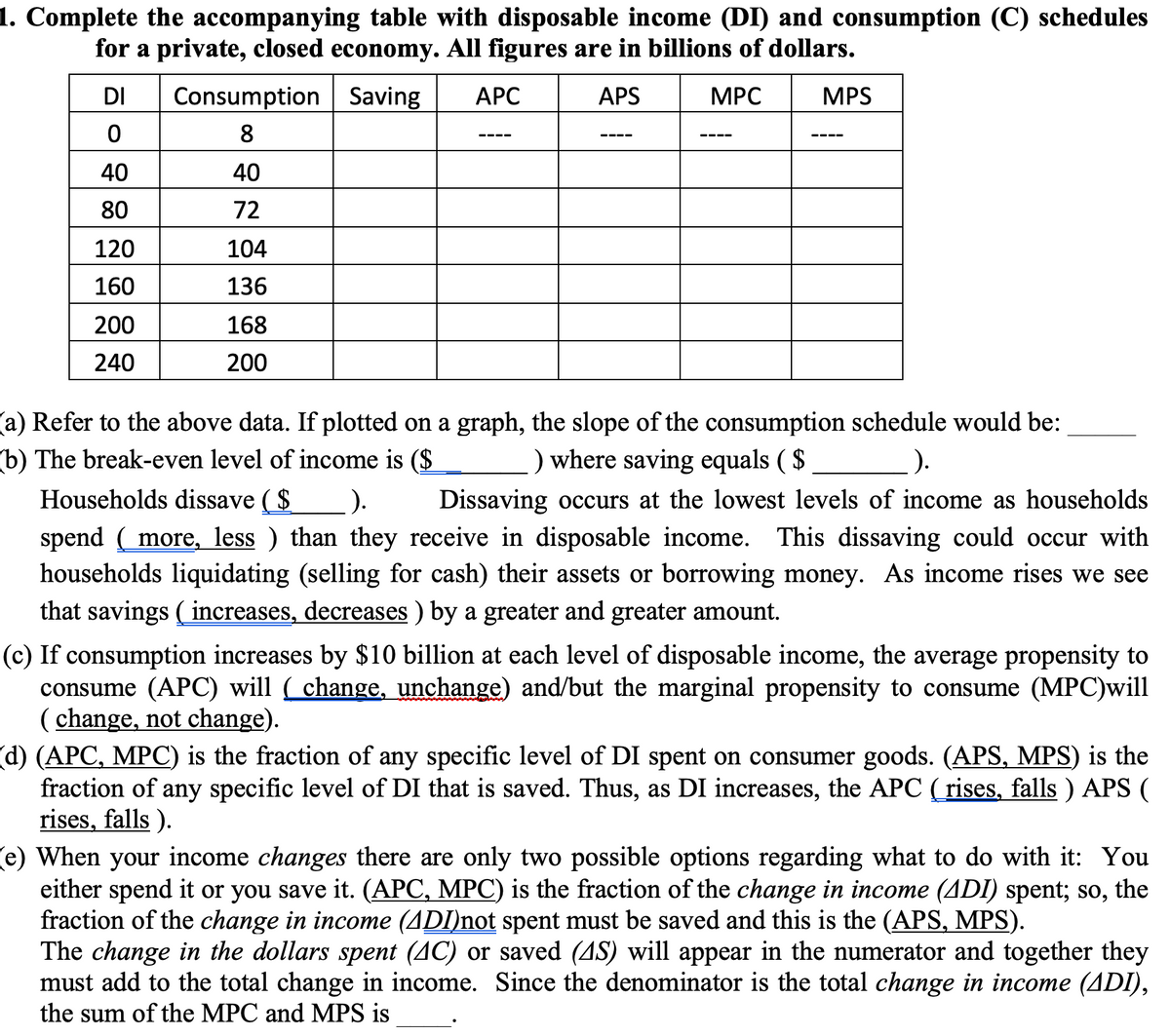Complete the accompanying table with disposable income (DI) and consumption (C) schedules for a private, closed economy. All figures are in billions of dollars. DI Consumption Saving АРС APS MPC MPS 8 ----- ---- ---- ---- 40 40 80 72 120 104 160 136 200 168 240 200 Refer to the above data. If plotted on a graph, the slope of the consumption schedule would be: O The break-even level of income is ($ ) where saving equals ( $
Complete the accompanying table with disposable income (DI) and consumption (C) schedules for a private, closed economy. All figures are in billions of dollars. DI Consumption Saving АРС APS MPC MPS 8 ----- ---- ---- ---- 40 40 80 72 120 104 160 136 200 168 240 200 Refer to the above data. If plotted on a graph, the slope of the consumption schedule would be: O The break-even level of income is ($ ) where saving equals ( $
Chapter9: Aggregate Demand
Section: Chapter Questions
Problem 1.1P
Related questions
Question

Transcribed Image Text:1. Complete the accompanying table with disposable income (DI) and consumption (C) schedules
for a private, closed economy. All figures are in billions of dollars.
DI
Consumption
Saving
АРС
APS
MPC
MPS
8.
40
40
80
72
120
104
160
136
200
168
240
200
(a) Refer to the above data. If plotted on a graph, the slope of the consumption schedule would be:
(b) The break-even level of income is ($
) where saving equals ( $
:).
Households dissave ( $
).
Dissaving occurs at the lowest levels of income as households
spend ( more, less ) than they receive in disposable income. This dissaving could occur with
households liquidating (selling for cash) their assets or borrowing money. As income rises we see
that savings ( increases, decreases ) by a greater and greater amount.
(c) If consumption increases by $10 billion at each level of disposable income, the average propensity to
consume (APC) will ( change, unchange) and/but the marginal propensity to consume (MPC)will
( change, not change).
(d) (APC, MPC) is the fraction of any specific level of DI spent on consumer goods. (APS, MPS) is the
fraction of any specific level of DI that is saved. Thus, as DI increases, the APC ( rises, falls ) APS (
rises, falls ).
(e) When your income changes there are only two possible options regarding what to do with it: You
either spend it or you save it. (APC, MPC) is the fraction of the change in income (ADI) spent; so, the
fraction of the change in income (ADI)not spent must be saved and this is the (APS, MPS).
The change in the dollars spent (AC) or saved (AS) will appear in the numerator and together they
must add to the total change in income. Since the denominator is the total change in income (ADI),
the sum of the MPC and MPS is
Expert Solution
This question has been solved!
Explore an expertly crafted, step-by-step solution for a thorough understanding of key concepts.
This is a popular solution!
Trending now
This is a popular solution!
Step by step
Solved in 3 steps

Knowledge Booster
Learn more about
Need a deep-dive on the concept behind this application? Look no further. Learn more about this topic, economics and related others by exploring similar questions and additional content below.Recommended textbooks for you


Macroeconomics: Principles and Policy (MindTap Co…
Economics
ISBN:
9781305280601
Author:
William J. Baumol, Alan S. Blinder
Publisher:
Cengage Learning



Macroeconomics: Principles and Policy (MindTap Co…
Economics
ISBN:
9781305280601
Author:
William J. Baumol, Alan S. Blinder
Publisher:
Cengage Learning
